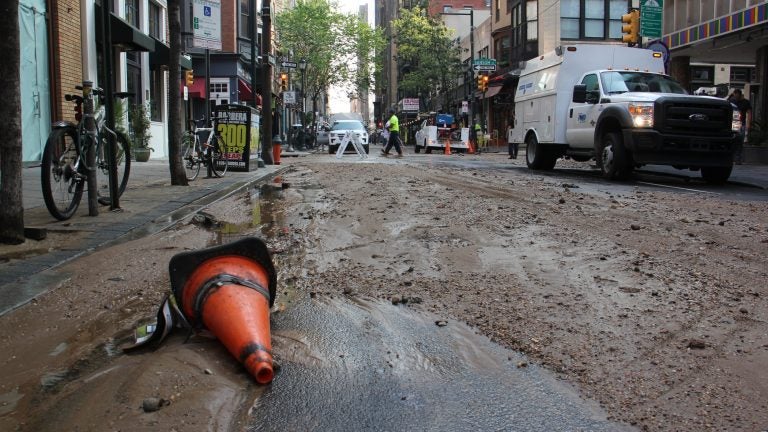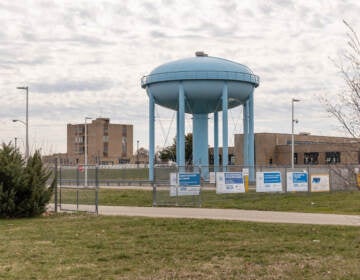After months of wrangling, a boost in city water rates will take effect in September
The city's water rate board has OK'd an increase in monthly water bills, with a slight bump in September and a bit more to come in 2019.

Silt and debris fill Center City streets around the site of a massive water main break. (Emma Lee/WHYY)
This story originally appeared on PlanPhilly.
—
Many months of complicated labor lie ahead for the Philadelphia Water Department as it repairs the major water-main break that flooded Center City earlier this month, but at least the department can say it knows exactly how it will pay for the project and its other expenses in the year ahead.
The city’s water rate board has OK’d an increase in monthly water bills, with a slight bump in September and a bit more to come in 2019. Approved July 12 after months of back-and-forth arguments between the Water Department and critics of the plan, the rate increases are much smaller than those originally requested but sufficient to cover the department’s needs, Water Commissioner Debra McCarty said.
The July 3 rupture of a nearly century-old main at Juniper and Sansom streets flooded the surrounding streets with 15 million gallons of water, knocked out power to hundreds of customers, and forced the long-term closure of neighboring blocks. Replacing the broken pipe is complex because of the “mess” of various utility lines under the street, McCarty said – and she now believes that repairs may not be completed, and streets closed up and paved, until the end of this year.
“Our design folks have been pretty much every day working on a design to replace this and working with the other utilities, because some of them have to get out of the way, so we can get in there and make the repairs we need to make,” she said.
“We are a resilient utility, and the rate board affirmed our financial metrics, which is so important. We have the capital and the in-house know-how to address something like this, and everything else we do,” McCarty said.
Water rates will increase 1.33 percent in fiscal year 2019, which starts in September, and another 1.2 percent in fiscal 2020. Because of the way different parts of a water bill are calculated, the typical residential customer who uses 500 cubic feet (5 ccf) of water a month will actually see a 17-cent drop in the monthly bill, to $66.33 this fall, and then an increase to $67.19 next year.
But a customer who uses about 6 ccf a month, the average across the system, will see an increase of 1 cent per month starting in September.
The Water Department had originally asked for three annual increases — 1.6 percent, 4.5 percent, and 4.5 percent, totaling nearly 11 percent. That would have boosted the typical residential bill to $73.79 — a cumulative increase of more than $7 a month, or $87 a year — by fiscal 2021.
The proposed increases and many other aspects of PWD’s financial plan were contested by Community Legal Services attorney Robert Ballenger, whom the rate board selected as public advocate to represent customers’ interest in the rate proceedings.
Ballenger said one of the board’s most significant decisions was to rule that the city could not shift the funding source for Philadelphia Fire Department water costs from taxpayers to water customers, as PWD had proposed. That decision alone cut the department’s need for rate hikes by $7.9 million and accounted for much of the reduction in proposed increases.
PWD noted that water utilities commonly include fire-hydrant costs in customers’ bills, and said that was fairer than charging taxpayers who may not live in the city and do not directly benefit from municipal fire protection. But the rate board agreed with Ballenger’s argument that city law specifically bars charging ratepayers for fire costs, and that City Council has not voted to change that policy.
“Without some clear authorization from City Council, this proposal was not going to go forward,” Ballenger said. “That is a big adjustment in this case, and a very positive aspect of the determination here.”
The independent five-member rate board, which includes City Treasurer Rasheia Johnson, also sided earlier this month with Ballenger’s argument that rates should be set only for the next two years rather than three, as PWD had requested. He said that historically the department’s long-term financial projections have been inaccurate, resulting in unnecessarily large rate increases and accumulations of surplus funds. McCarty said she had wanted a longer respite before the next time-consuming, multimillion-dollar rate case.
Reserve funds were another area of dispute. The rate board determined that PWD should aim for a combined $150 million in its two reserve accounts, less than the $165 million requested and more than the $100 million the public advocate said was appropriate.
Even with that decision, the Water Department projects that it won’t spend its current $200 million in reserves down to the target figure for at least five years. Ballenger said that could mean PWD will be hoarding funds that could instead be used to lower water bills, and that he is considering filing another appeal questioning those projections.
Much of the legal jousting in the case stemmed from differences over how best to protect customers’ pocketbooks while ensuring the Water Department’s financial stability. Ballenger and outside experts he retained repeatedly argued that the department overestimates how much it needs to charge for water and does not do enough to make sure that ratepayers, especially lower-income residents, can afford their bills. For example, they challenged PWD’s projected future costs for staffing, chemicals, energy, and debt issuance, resulting in a combined $4.5 million cut in those budget lines for the coming year.
McCarty, meanwhile, said the bond-rating agencies that monitor the department’s financial health often note that it has a noticeably high debt burden and want to see it maintain large reserves to reassure them that it can pay its debtors.
“It’s a balance, because the bondholders and the rating agencies want to see that you have enough money in reserve, and that’s why we keep our A and A-plus ratings,” she said. “When you keep those A and A-plus ratings, you can borrow money at better interest rates, and capital costs less for our ratepayers. That’s so important to us. We care very much about our ratings, and we worry about being heavily leveraged.”
McCarty noted that PWD is assisting lower-income customers through its new Tiered Assistance Program, or TAP, which allows qualifying households to pay low, fixed monthly bills based on their income. Close to 13,000 customers have enrolled in the past 13 months, and she said she’d like the program to include at least 20,000 eventually. The department hopes to expand enrollment when an improved online application debuts later this year.
Ballenger and his experts said that the department could do more outreach to potential TAP participants, and that it also is obliged by city law to provide better access to arrearage forgiveness, under which old overdue water bills are permanently erased.
Once a customer enrolls in TAP, any debt that is at least 15 years old is forgiven — which means that after 15 years of TAP participation, all a customer’s unpaid bills could be erased. Ballenger said the law authorizing TAP requires PWD to provide more arrearage forgiveness, which he noted could be done by speeding up the forgiveness schedule. The rate board directed the Water Department to investigate and explain why more has not been done.
McCarty said she will comply, but she questioned Ballenger’s focus on arrearage forgiveness, saying that it does not affect customers’ access to water. Once a customer submits a TAP application, water cannot be shut off for nonpayment, and after a customer is enrolled and makes two years of on-time bill payments, old penalties are waived, she said.
The water commissioner said she also wants to avoid creating a “loophole” that would allow someone to game the system by quickly obtaining forgiveness and then resuming non-payment of water bills.
WHYY is your source for fact-based, in-depth journalism and information. As a nonprofit organization, we rely on financial support from readers like you. Please give today.







